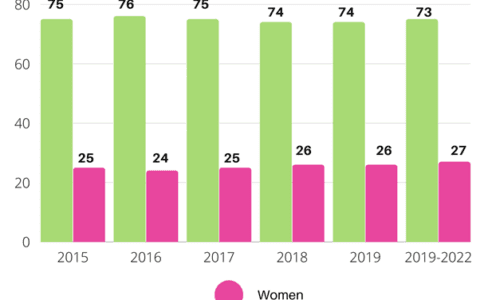The Job Market for Women in STEM

Firstly, let’s start off by saying, there is no such thing as a job for a woman in STEM, any more than there is a job for a man in STEM; as long as you have the relevant qualifications and skills then your sex should not matter. However, it is a fact that women are hugely under-represented within STEM-related industries. According to the WISE Campaign, women make up 26.3% of the workforce in 2022. This is a 4.3% increase over 4 years but, clearly, a step-change is needed to reach parity in STEM.
When you break down the numbers further, the picture doesn’t get much better. Only in Science do women make up more than a quarter of the entire workforce.
| Profession | % of women* |
| Engineering professionals | 12.4% |
| Science professionals | 48.9% |
| Science and engineering technicians | 29.5% |
| Science Engineering and Tech Management | 18.1% |
| IT professionals | 18.8% |
| IT technicians | 21.9% |
| *All data from WISE 2022 |
The issue of gender inequality in STEM is well documented and is being addressed by a number of initiatives across the country. At STEM Women we are contributing to this effort: our events are designed to create a community of women and non-binary students and graduates, where they can connect with employers across STEM industries, raise their aspirations and find out about new opportunities.
Well paid jobs for women
According to the Employee Earnings in the UK survey by the Office for National Statistics (ONS), the average annual salary in the UK in 2022 was £33,000. The average graduate salary in the UK is £24,000 according to Save the Student. When looking across the board, STEM is a well-paid industry and is considered a wealth generator, which is why governments and industry pay so much attention to the current skills shortage.
The average salary for STEM careers in the UK
Below, we outline the average salary for a number of popular STEM jobs. Remember these are only averages and take into account remuneration from all levels of roles. These numbers are not necessarily starting salaries. How much you will get paid varies enormously due to a number of factors such as location, your degree classification and university, your experience, industry trends and your ability to negotiate a salary.
| Job title | Average salary* |
| Civil engineer | £50,702 |
| Chemical engineering | £49,584 |
| Bioscience | £36,731 |
| Scientist | £43,601 |
| Statistician | £49,876 |
| Electrical engineering | £43,233 |
| Data analyst | £47,488 |
| Software engineer | £61,171 |
| Physicist | £48,167 |
| Lab technician | £29,287 |
| Pharmacy | £42,740 |
*Data taken from Adzuna in July 2023. Statistics are based on their database of jobs ads and does not take into consideration any gender pay gaps.
As we can see, almost every job in the table above is higher than the ONS average salary, so we can say that the earning potential of STEM roles tends to be positive.
Jobs in STEM where women dominate
 It might be surprising, but there are some areas of STEM in which women dominate, such as pharmacy and teaching STEM. 62% of pharmacists are women, according to the General Pharmaceutical Council’s Equality, Diversity and Inclusion report (2019), and when it comes to teaching STEM subjects, a report by the Royal Society back in 2007 indicated that considerably more women than men have entered this profession in all STEM areas other than physics.
It might be surprising, but there are some areas of STEM in which women dominate, such as pharmacy and teaching STEM. 62% of pharmacists are women, according to the General Pharmaceutical Council’s Equality, Diversity and Inclusion report (2019), and when it comes to teaching STEM subjects, a report by the Royal Society back in 2007 indicated that considerably more women than men have entered this profession in all STEM areas other than physics.
According to the Royal Society, women are not underrepresented in the overall scientific workforce, however they are highly underrepresented in most senior roles.
While there are some areas of STEM where women are starting to become a majority, many of these roles are within the lower paying sectors. For example, the average salary for teachers in the UK is £33,162 – only just over the national average which of course includes non-graduates.
The STEM gender pay gap
The gender pay gap in STEM is a big issue. According to the New Scientist, the gender pay gap in STEM widened in 2022, from 19.4% to almost 28% in the UK, and from 7% to 17% in Europe. Similarly, a survey by fintech firm Spendesk showed that women in the UK finance industry earn 30% less than their male counterparts.
The impact of the pandemic has been cited as a possible factor for the widening gender pay gap, as more women took on increased childcare responsibilities or were overlooked due to working remotely. Many organisations have recognised this problem, taking the necessary steps to recruit and retain women and non-binary people within their workforce, ensuring that gender pay gaps are addressed, and offering increased support to women throughout their careers.
Despite the issues surrounding women in STEM, it is still a career path that, for many, has the dual benefits of being financially rewarding and exciting, meaningful work; STEM industries have potential to enact huge changes in the world around us and so it is, of course, essential that women are part of this process.
At STEM Women we address the gender imbalance in STEM by hosting networking and recruitment events across the UK, Europe and Australia. Sign up to your nearest event today!




